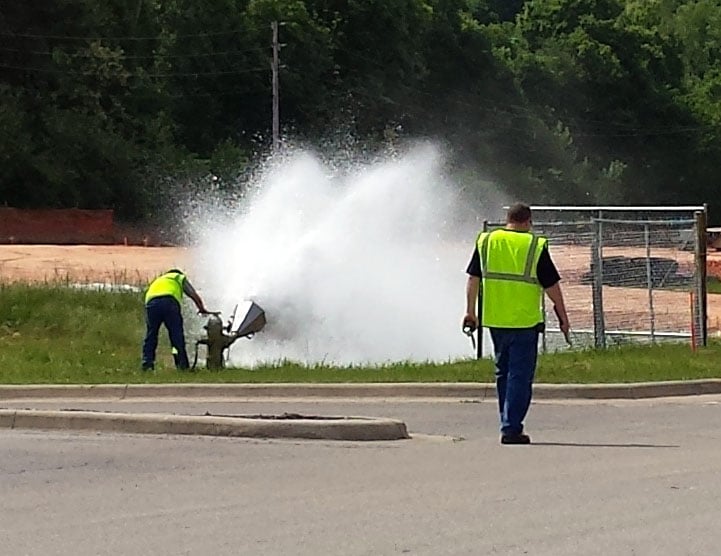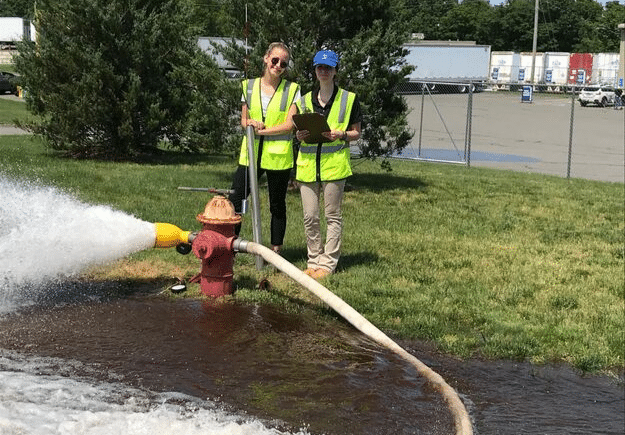 With the beginning of each new year come all sorts of resolutions – to eat better, spend less, organize the house, and clean the garage. But the most commonly made resolution by far is to exercise to get into better shape. And while we agree with this resolution 100%, it may not be for the reasons you think. You see, we think you DO need to exercise – your fire hydrants!
With the beginning of each new year come all sorts of resolutions – to eat better, spend less, organize the house, and clean the garage. But the most commonly made resolution by far is to exercise to get into better shape. And while we agree with this resolution 100%, it may not be for the reasons you think. You see, we think you DO need to exercise – your fire hydrants!
Hydrant Calisthenics
Exercising hydrants comes in the form of unidirectional flushing (UDF) which, just as the name implies, flushes water in one direction from the cleanest possible source, such as a well, outward to dirty mains, finally exiting a hydrant. This unique process is utilized to maintain a distribution system as well as learn critical information about the system, allowing utilities to make future improvements based on the information acquired. The primary goal of UDF is to clean water mains, removing as much sediment, debris, and loose tuberculation as possible. Performing unidirectional flushing on an annual basis helps to avoid tuberculation and sedimentation buildup. Water mains that are not flushed on a regular, scheduled basis run the risk of building up tuberculation to the point that the buildup cannot be removed by flushing, and this can have a significantly negative impact on water quality, fire flows, and distribution system efficiency.
 While the primary objective of unidirectional flushing is to clean mains, there are also many secondary goals and benefits. Exercising hydrants and valves prolongs the life of the valves while also locating closed or broken valves. In addition, flushing helps to narrow down a search area when trying to determine the cause of water quality or pressure issues in a specific area of the system. In a best case scenario, the flushing will actually alleviate the water quality issues by flushing out any debris or buildup that is causing the problem. Also, there are often discrepancies between the hydraulic model and the distribution system that can be discovered and addressed during flushing. Lastly, flushing helps to determine or disprove suspected system issues. Frequently, these issues are not of an emergency nature and can either be readily corrected during the flushing process or can be scheduled for repair at a convenient time, BEFORE they require critical attention.
While the primary objective of unidirectional flushing is to clean mains, there are also many secondary goals and benefits. Exercising hydrants and valves prolongs the life of the valves while also locating closed or broken valves. In addition, flushing helps to narrow down a search area when trying to determine the cause of water quality or pressure issues in a specific area of the system. In a best case scenario, the flushing will actually alleviate the water quality issues by flushing out any debris or buildup that is causing the problem. Also, there are often discrepancies between the hydraulic model and the distribution system that can be discovered and addressed during flushing. Lastly, flushing helps to determine or disprove suspected system issues. Frequently, these issues are not of an emergency nature and can either be readily corrected during the flushing process or can be scheduled for repair at a convenient time, BEFORE they require critical attention.
 According to The American Water Works Association (AWWA), “distribution system deficiencies continue to be responsible for more then 25 percent of waterborne disease outbreaks in the United States each year, a statistic that underscores the need for water suppliers to effectively control water quality within the distribution system. Flushing is one of the most powerful tools available to a water utility for maintaining this control.” For this reason, AWWA has published a set of guidelines to follow when implementing a unidirectional flushing program. They recommend a minimum velocity of 3.0 feet per second, and also recommend that system pressure in the surrounding area maintain 20 psi, similar to the concept of adequate fire flow availability.
According to The American Water Works Association (AWWA), “distribution system deficiencies continue to be responsible for more then 25 percent of waterborne disease outbreaks in the United States each year, a statistic that underscores the need for water suppliers to effectively control water quality within the distribution system. Flushing is one of the most powerful tools available to a water utility for maintaining this control.” For this reason, AWWA has published a set of guidelines to follow when implementing a unidirectional flushing program. They recommend a minimum velocity of 3.0 feet per second, and also recommend that system pressure in the surrounding area maintain 20 psi, similar to the concept of adequate fire flow availability.
Conclusion
There is a great deal of information that can be gathered during flushing, and the better the quality of data recorded, the easier it is to compare data, making it easier to determine if changes are occurring or if a problem has developed in the distribution system. Each step of the process is important, and a successful flushing program is a continuous process. The data should be compared on a yearly basis, at a minimum. Gaining five pounds over the course of one year seems insignificant; however, gaining five pounds per year over a course of five years will find a person with his weight up 25 pounds — and that IS significant. The same holds true for distribution systems. If the data is not reviewed annually, small problems have the potential to become large problems, and simple system improvements run the risk of being overlooked.
So while you are making your new year’s resolutions, be sure to include exercise…of your hydrants — your distribution system, customers, and operators will surely thank you. Happy New Year!
